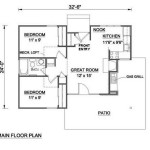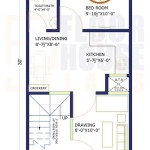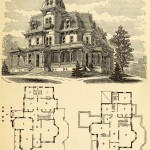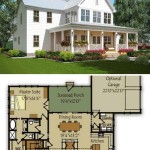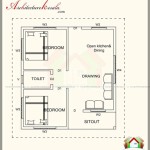Finding the Floorplan of Your House: A Comprehensive Guide
Obtaining a floorplan of a house is crucial for various purposes, ranging from planning renovations and interior design projects to resolving property disputes and understanding the structural integrity of the building. A floorplan provides a bird's-eye view of the house's layout, showcasing the arrangement of rooms, dimensions, and the location of essential elements such as doors, windows, and plumbing fixtures. This article explores several methods for acquiring a floorplan of a property, outlining both official and alternative approaches.
The ease with which a homeowner can find an existing floorplan significantly depends on factors such as the age of the house, local regulations, and the thoroughness of record-keeping practices in the area. Newer houses are more likely to have readily available floorplans due to stricter building codes and digital archiving systems. Older homes, especially those built before the widespread use of computers, may require more extensive research and potentially necessitate the creation of a new floorplan through professional surveying.
Checking Official Records and Sources
The first and often most reliable place to start the search for a house's floorplan is with official records. Local government authorities, such as the city hall or county recorder's office, are often repositories for building plans and permits. These records are typically public and accessible for review, although accessing them may require navigating bureaucratic processes and paying nominal fees. The types of documents that may contain floorplans include:
Building Permits: These documents are required before any significant construction or renovation work can be carried out. Building permits often include detailed floorplans that were submitted as part of the application process. The level of detail in these plans can vary, but they usually provide a comprehensive overview of the house's layout and dimensions. Requesting copies of building permits related to the initial construction of the house or any subsequent additions or modifications is a valuable starting point.
Property Records: Local land registries and property assessor's offices maintain records related to property ownership and assessed value. While these records may not always include detailed floorplans, they can sometimes contain simplified diagrams or sketches outlining the house's basic dimensions and layout. These sketches might be sufficient for basic planning purposes or provide clues that lead to more detailed plans.
Tax Assessor's Maps: Some jurisdictions maintain detailed maps for property tax assessment purposes. These maps may include the outlines of buildings and their dimensions. Although not as detailed as architectural floorplans, these maps can provide a general understanding of the house's footprint and its relationship to the property boundaries.
Historical Societies and Archives: For older homes, historical societies or local archives may hold valuable information, including original building plans or historical documents that contain floorplans. These sources can be particularly useful for researching the history of a property and understanding how its layout has evolved over time. However, access to these records may be limited, and preservation concerns may restrict the ability to make copies.
When contacting official sources, it is essential to have as much information about the property as possible, including the street address, legal description (property identification number), and approximate year of construction. This information will help the clerks and archivists locate the relevant records more efficiently.
Contacting Previous Owners, Builders, and Architects
If official records do not yield a floorplan, reaching out to individuals or entities involved in the house's construction or previous ownership can be a viable alternative. This approach requires some detective work and networking, but it can potentially uncover valuable information that is not readily available through public sources.
Previous Owners: Contacting previous owners, if possible, can be a fruitful avenue. They may have retained copies of the original floorplans or possess other documents related to the house's construction or renovation. Even if they do not have a physical copy of the floorplan, they may be able to provide valuable insights into the house's layout and any modifications that were made over time. Social media platforms and online search engines can be used to locate previous owners.
Builders and Developers: If the house is relatively new or part of a planned development, contacting the original builder or developer can be a successful strategy. They may have records of the floorplans, especially if the house was built as part of a larger project. Even if the original builder is no longer in business, their successor company or a related firm may have access to the records. Similarly, contacting the architectural firm that designed the house can potentially yield floorplans.
Real Estate Agents: The real estate agent who sold the house may have access to floorplans that were used for marketing purposes. Although these floorplans may not be as detailed as architectural drawings, they can provide a general sense of the house's layout and dimensions. Real estate agents often retain marketing materials for some time after a sale, so it is worth contacting them to inquire about the availability of floorplans.
When contacting these individuals or entities, it is crucial to be polite, professional, and clearly explain the reason for the inquiry. Providing as much information about the property as possible will help them locate any relevant documents more efficiently. It is also important to respect their privacy and confidentiality policies.
Creating a New Floorplan
If all other avenues have been exhausted, and an existing floorplan cannot be located, the only remaining option may be to create a new floorplan. This can be accomplished through several methods, ranging from manual measurement and drafting to the use of sophisticated laser scanning technology.
Manual Measurement and Drafting: This involves physically measuring the dimensions of each room and exterior of the house using a measuring tape or laser distance measurer. The measurements are then used to create a scaled drawing of the floorplan, either by hand or using computer-aided design (CAD) software. This method requires accuracy and attention to detail, but it can be a cost-effective way to create a floorplan for simple houses. It is important to note the location of all doors, windows, and fixed fixtures, such as plumbing and electrical outlets.
Professional Surveying: Hiring a professional surveyor or architect to create a floorplan is the most accurate and reliable method. Surveyors use specialized equipment, such as laser scanners and total stations, to precisely measure the dimensions of the house and create a detailed floorplan. This method is particularly useful for complex houses with irregular shapes or multiple levels. The surveyor will typically provide a digital floorplan that can be easily modified and used for various purposes.
3D Scanning and Modeling: 3D scanning technology is increasingly being used to create floorplans and virtual models of houses. This method involves using a laser scanner or other 3D imaging device to capture a point cloud of the house's interior. The point cloud is then processed to create a detailed 3D model, which can be used to generate floorplans and other architectural drawings. This method is particularly useful for creating accurate and comprehensive representations of complex spaces, but it can be more expensive than manual measurement or professional surveying.
DIY Floorplan Apps: Several mobile applications and online tools are available that allow homeowners to create floorplans using their smartphones or tablets. These apps typically use the device's camera and augmented reality (AR) technology to measure distances and create a basic floorplan. While these apps can be convenient and easy to use, their accuracy may be limited, and they may not be suitable for creating detailed floorplans for complex houses.
Regardless of the method chosen, it is essential to ensure that the floorplan is accurate and complete. This may involve verifying measurements, double-checking the location of fixtures, and ensuring that all relevant architectural details are included. A well-prepared floorplan can be a valuable asset for homeowners, providing a visual representation of their house's layout and dimensions that can be used for a variety of purposes.
The importance of having a correct floor plan is paramount when selling your home. A study by Zillow found that homes with floor plans tend to sell up to 7 days faster and often for a higher price. Floor plans help potential buyers visualize the space, furniture placement, and flow of the home. This visual aid simplifies the decision-making process and can significantly increase the home's appeal.
Furthermore, floor plans are essential for effective property management. Landlords and property managers use floor plans for various purposes, including tenant screening, maintenance planning, and emergency response. Precise floor plans help in assigning maintenance tasks effectively, planning renovations, and quickly locating specific features or areas for repairs. In emergency situations, floor plans assist first responders in navigating the property efficiently, ensuring tenant safety.
Finally, floor plans are also invaluable for interior designers and architects. By having an accurate floor plan, designers can create detailed layouts and furniture arrangements that optimize the available space. Architects utilize floor plans to plan renovations, expansions, or modifications to the existing structure. This ensures that the design is feasible and complies with building codes and regulations, ultimately saving time and reducing potential errors during the construction phase.

Archimple Finding Building Plans And Floor For Your House Tips Resources

How To Find The Original Floor Plans For Your House

9 Ways To Find Floor Plans Of An Existing House Archid

As Built Floor Plans

Archimple How To Find Floor Plans For My Apartment Unlocking The Blueprint Of Your Ideal Living Space

Design Your Own House Floor Plans Roomsketcher

Design Your Own House Floor Plans Roomsketcher

Archimple How To Find Floor Plans For My Apartment Unlocking The Blueprint Of Your Ideal Living Space

How To Read A Floor Plan With Dimensions Houseplans Blog Com

How To Read Floor Plans

